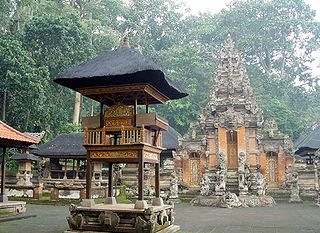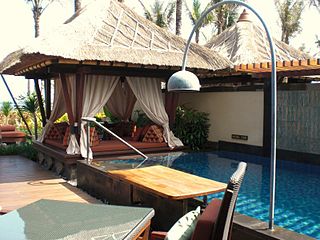
Sacred geometry ascribes symbolic and sacred meanings to certain geometric shapes and certain geometric proportions. It is associated with the belief of a divine creator of the universal geometer. The geometry used in the design and construction of religious structures such as churches, temples, mosques, religious monuments, altars, and tabernacles has sometimes been considered sacred. The concept applies also to sacred spaces such as temenoi, sacred groves, village greens, pagodas and holy wells, Mandala Gardens and the creation of religious and spiritual art.

Prambanan is a 9th-century Hindu temple compound in the Special Region of Yogyakarta, in southern Java, Indonesia, dedicated to the Trimūrti, the expression of God as the Creator (Brahma), the Preserver (Vishnu) and the Destroyer (Shiva). The temple compound is located approximately 17 kilometres (11 mi) northeast of the city of Yogyakarta on the boundary between Central Java and Yogyakarta provinces.

Ubud is a town on the Indonesian island of Bali in Ubud District, located amongst rice paddies and steep ravines in the central foothills of the Gianyar regency. Promoted as an arts and culture centre, it has developed a large tourism industry. It forms a northern part of the Greater Denpasar metropolitan area.

Besakih Temple is a pura complex in the village of Besakih on the slopes of Mount Agung in eastern Bali, Indonesia. It is the most important, largest, and holiest temple of Balinese Hinduism, and one of a series of Balinese temples. Perched nearly 1000 meters up the side of Gunung Agung, it is an extensive complex of 23 separate but related temples with the largest and most important being Pura Penataran Agung. The temple is built on six levels, terraced up the slope. The entrance is marked by a candi bentar, and beyond it, the Kori Agung is the gateway to the second courtyard.

Sacred groves of India are forest fragments of varying sizes, which are communally protected, and which usually have a significant religious connotation for the protecting community. Hunting and logging are usually strictly prohibited within these patches. Other forms of forest usage like honey collection and deadwood collection are sometimes allowed on a sustainable basis. NGOs work with local villagers to protect such groves. Traditionally, and in some cases even today, members of the community take turns to protect the grove. The introduction of the protected area category community reserves under the Wild Life (Protection) Amendment Act, 2002 has introduced legislation for providing government protection to community held lands, which could include sacred groves.

Aryankavu is a village located in the Kollam district of the Indian state of Kerala. It lies close to the border between Kerala and Tamil Nadu near Thenmala. It is also one of the famous pilgrimage sites associated with the legend of Sabarimala. The village is located beside Shendurney Wildlife Sanctuary.

Mandala Suci Wenara Wana, also known as Ubud Monkey Forest, is a sanctuary located in Padangtegal, Ubud, Bali, Indonesia.

The Puri Lukisan Ratna Wartha Museum is the oldest art museum in Bali which specialize in modern traditional Balinese paintings and wood carvings. The museum is located in Ubud, Bali, Indonesia. It is home to the finest collection of modern traditional Balinese painting and wood carving on the island, spanning from the pre-Independence war (1930–1945) to the post-Independence war era. The collection includes important examples of all of the artistic styles in Bali including the Sanur, Batuan, Ubud, Young Artist and Keliki schools.

Goa Gajah, or Elephant Cave, is located on the island of Bali near Ubud, in Indonesia. Built-in the 9th century, it served as a sanctuary.

The Moon of Pejeng, also known as the Pejeng Moon, in Bali is the largest single-cast bronze kettle drum in the world. and "the largest known relic from Southeast Asia's Bronze Age period." It is "considered highly sacred by local people." It is thought to be a relic of early rice cultivation rituals.

Pejeng is a village in Bali, Indonesia, in the Petanu River valley. It is a bit east of Ubud in Gianyar Regency. It is home to the Moon of Pejeng, the largest single-cast bronze kettle drum in the world. Pejeng is a rural area with extensive, and ancient, irrigated rice cultivation.

Prambanan Temple Compounds is the World Heritage designation of a group of Hindu temple compounds that lie on the border between Yogyakarta and Central Java, Indonesia. It comprises Prambanan, Lumbung, Bubrah and Sewu temple compounds, all are located within Prambanan Archaeological Park.

Pura Dalem Agung Padangtegal, or Padangtegal Great Temple of Death, is one of three Hindu temples making up a temple complex located in the Sacred Monkey Forest Sanctuary – commonly called the "Ubud Monkey Forest" – of Padangtegal, Ubud, Bali, Indonesia.

A Pura is a Balinese Hindu temple and the place of worship for adherents of Balinese Hinduism in Indonesia. Puras are built following rules, style, guidance, and rituals found in Balinese architecture. Most puras are found on the island of Bali, where Hinduism is the predominant religion; however many puras exist in other parts of Indonesia where significant numbers of Balinese people reside. Mother Temple of Besakih is the most important, largest, and holiest temple in Bali. Many Puras have been built in Bali, leading it to be titled "the Island of a Thousand Puras".

Balinese architecture is a vernacular architecture tradition of Balinese people that inhabits the volcanic island of Bali, Indonesia. Balinese architecture is a centuries-old architectural tradition influenced by Balinese culture developed from Hindu influences through ancient Javanese intermediary, as well as pre-Hindu elements of native Balinese architecture.

The Ubud Palace, officially Puri Saren Agung, is a historical building complex situated in Ubud, Gianyar Regency of Bali, Indonesia.

Mengwi is a district (kecamatan) in the Badung Regency, Bali, Indonesia and also covers Bali's heaviest tourist regions, situated to the north of Kuta District and North Kuta District, and including Canggu. It covers an area of 82.0 km2 and had a population of 122,829 at the 2010 Census and 132,786 at the 2020 Census.

Pura Goa Lawah is a Balinese Hindu temple or a pura located in Klungkung, Bali, Indonesia. Pura Goa Lawah is often included among the Sad Kahyangan Jagad, or the "six sanctuaries of the world", the six holiest places of worship on Bali. Pura Goa Lawah is noted for being built around the opening of a cave which is inhabited by bats, hence its name, the Goa Lawah or "bat cave".
Pura Dalem Sakenan is a pura located at the north-western shore of Serangan, a small island about 10 kilometres (6.2 mi) south of Denpasar, Bali. Pura Dalem Sakenan is dedicated to [rambut sedhana] and is associated with prosperity. Pura Dalem Sakenan is the focus temple of the 210-day Piodalan festival where in the past processions of pilgrims visited the island on foot or by traditional colorful wooden boats called jukung. With the construction of the bridge connecting the Serangan island with Bali as well as the reclamation of the island, the use of colorful jukung for pilgrimage has died out.

Penglipuran is one of the traditional villages or kampung located in Bangli Regency, Bali Province, Indonesia. The village is famous as a tourist destinations in Bali because the villagers still preserve their traditional culture in their daily lives. The architecture of buildings and land processing still follow the concept of Tri Hita Karana, the philosophy of Balinese society regarding the balance of relations between God, humans and their environment. Penglipuran succeeded in building tourism that benefited all of its community without losing its culture and traditions. In 1995, Penglipuran also received a Kalpataru award from the Indonesian government for its efforts to protect the bamboo forest in their local ecosystem.




















